Mercedes-Benz GLK-Class: Flat tire
Preparing the vehicle
- Stop the vehicle as far away as possible from traffic on solid, non-slippery and level ground.
- Switch on the hazard warning lamps.
- Firmly depress the parking brake.
- Bring the front wheels into the straightahead position.
- Move the selector lever to P.
- Switch off the engine.
- Vehicles without KEYLESS-GO: remove the SmartKey from the ignition lock.
- Vehicles with KEYLESS-GO: open the driver's door. The on-board electronics have status 0, which is the same as the SmartKey having been removed.
- Vehicles with KEYLESS-GO: remove the Start/Stop button from the ignition lock ().
- All occupants must get out of the vehicle. Make sure that they are not endangered as they do so.
- Make sure that no one is near the danger area while a wheel is being changed. Anyone who is not directly assisting in the wheel change should, for example, stand behind the barrier.
- Get out of the vehicle. Pay attention to traffic conditions when doing so.
- Close the driver's door.
Changing a wheel and mounting the spare wheel
Preparing the vehicle
![]() WARNING
WARNING
The wheel and tire size of the emergency spare wheel/spare wheel may differ to that of the damaged wheel. When using an emergency spare wheel/spare wheel the handling characteristics of the vehicle may change.
Adapt your style of driving accordingly. Never operate the vehicle with more than one emergency spare wheel/spare wheel that differs in size.
Only use an emergency spare wheel/spare wheel of a differing size briefly and do not switch off ESP®.
When using an emergency spare wheel, you must not exceed the maximum speed of 50 mph (80 km/h).
![]() WARNING
WARNING
Have the emergency spare wheel/spare wheel replaced with a new wheel as soon as possible at a qualified specialist workshop which has the necessary specialist knowledge and tools to carry out the work required. Mercedes-Benz recommends that you use an authorized Mercedes-Benz Center for this purpose. In particular, work relevant to safety or on safety-related systems must be carried out at a qualified specialist workshop.
![]() Vehicles without a spare wheel/ emergency spare wheel are not equipped with
a tire-change tool kit at the factory. For more information on which tools are required
to perform a wheel change on your vehicle, e.g. wheel chock, lug wrench or alignment
bolt, consult an authorized Mercedes-Benz Center.
Vehicles without a spare wheel/ emergency spare wheel are not equipped with
a tire-change tool kit at the factory. For more information on which tools are required
to perform a wheel change on your vehicle, e.g. wheel chock, lug wrench or alignment
bolt, consult an authorized Mercedes-Benz Center.
- Prepare the vehicle as described ().
- If a trailer is coupled to the vehicle, uncouple it.
- Remove the following items (depending on the vehicle's equipment) from the stowage well under the trunk floor:
- the emergency spare wheel
- the wheel bolts for the emergency spare wheel
- the tire inflation compressor
- the lug wrench
- the folding wheel chock
- the jack
- the ratchet wrench
- Secure the vehicle to prevent it from rolling away.
Securing the vehicle to prevent it from rolling away
![]() WARNING
WARNING
Only jack up the vehicle on level ground or on slight inclines/declines. The vehicle could otherwise fall off the jack and injure you or others.
If your vehicle is equipped with a wheel chock, it can be found in the vehicle tool kit ().
The folding wheel chock is an additional securing measure to prevent the vehicle from rolling away, for example when changing a wheel.
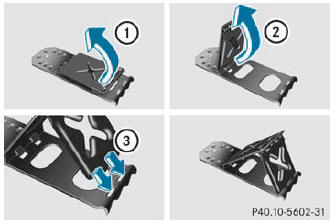
- Fold both plates upwards 1.
- Fold out lower plate 2.
- Guide the lugs on the lower plate fully into the openings in base plate 3.

Securing the vehicle on level ground
X On level ground: place chocks or other suitable items under the front and rear of the wheel that is diagonally opposite the wheel you wish to change.
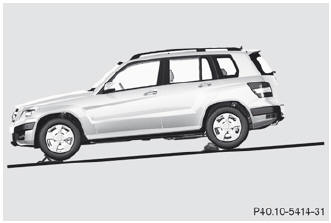
Securing the vehicle on slight downhill gradients
- On downhill gradients: place chocks or other suitable items in front of the wheels of the front and rear axle.
Raising the vehicle
![]() WARNING
WARNING
When jacking up the vehicle, only use the jack which has been specifically approved by Mercedes-Benz for your vehicle.
The jack is designed exclusively for jacking up the vehicle at the jacking points built into both sides of the vehicle. The jack saddle must be placed centrally under the jacking point. The jack must always be vertical when in use, especially on inclines or declines.
The jack is intended only for lifting the vehicle briefly for wheel changes. It is not suited for performing maintenance work under the vehicle. To help avoid personal injury, use the jack only to lift the vehicle during a wheel change.
Never get beneath the vehicle while it is supported by the jack. Keep hands and feet away from the area under the lifted vehicle. Always lower the vehicle onto sufficient capacity jackstands before working under the vehicle.
Always firmly engage the parking brake and block the wheels with wheel chocks or other sizable objects before raising the vehicle with the jack. Do not disengage the parking brake while the vehicle is raised.
Make sure that the ground on which the vehicle is standing and where you place the jack is solid, level and not slippery. If necessary, use a large underlay. On slippery surfaces, such as tiled floors, you should use a non-slip underlay, for example a rubber mat. Do not use wooden blocks or similar objects as a jack underlay. Otherwise, the jack may not be able to achieve its load-bearing capacity if it is not at its full height. Never start the engine when the vehicle is raised.
Also observe the notes on the jack.
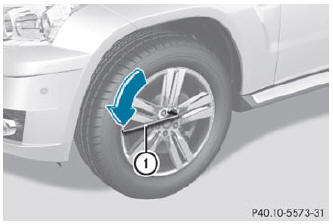
- Using lug wrench 1, loosen the bolts on the wheel you wish to change by about one full turn. Do not unscrew the bolts completely.
The jacking points for the jack are located behind the wheel housings of the front wheels and in front of the wheel housings of the rear wheels (arrows).
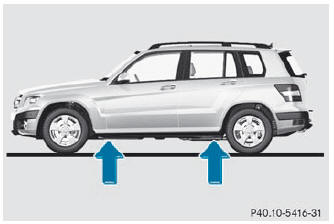
![]() WARNING
WARNING
The jack is designed exclusively for jacking up the vehicle at the jacking points. The jack saddle must be placed centrally under the jacking point.
If you do not position the jack correctly in the jacking point, the vehicle can fall off the jack and seriously or fatally injure you or others.
![]() The jack is designed exclusively for jacking up the vehicle at the jacking
points. Otherwise, your vehicle could be damaged.
The jack is designed exclusively for jacking up the vehicle at the jacking
points. Otherwise, your vehicle could be damaged.
- Take the ratchet wrench out of the vehicle tool kit and place it on the hexagon nut of the jack so that the letters AUF are visible.
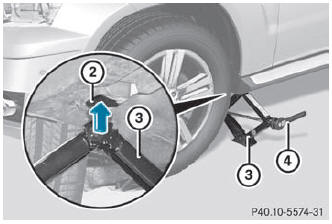
- Position jack 3 at jacking point 2.
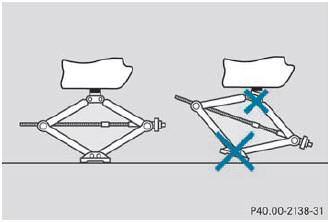
- Make sure that the base of the jack is positioned directly under the jacking point.
- Turn ratchet wrench 4 until jack 3 sits completely on jacking point 2 and the base of the jack lies evenly on the ground.
- Turn ratchet wrench 4 until the tire is raised a maximum of 1.2 inches (3 cm) off the ground.
Removing a wheel
- Unscrew the wheel bolts.
![]() Do not place wheel bolts in sand or on a dirty surface. The bolt and wheel
hub threads could otherwise be damaged when you screw them in.
Do not place wheel bolts in sand or on a dirty surface. The bolt and wheel
hub threads could otherwise be damaged when you screw them in.
- Remove the wheel.
Mounting a new wheel
![]() WARNING
WARNING
Always replace wheel bolts that are damaged or rusted.
Never apply oil or grease to wheel bolts. Damaged wheel hub threads should be repaired immediately. Do not continue to drive under these circumstances! Contact an authorized Mercedes-Benz Center or call Roadside Assistance.
Incorrect wheel bolts or improperly tightened wheel bolts can cause the wheel to come off.
This could cause an accident. Make sure to use the correct wheel bolts.
![]() WARNING
WARNING
Only use genuine Mercedes-Benz wheel bolts. Other wheel bolts may come loose.
Do not tighten the wheel bolts when the vehicle is raised. Otherwise, the vehicle could fall off the jack.

- : Wheel bolts for all wheels supplied by the factory
- ; Wheel bolts for the collapsible spare wheel
![]() Always use wheel bolts 2 to mount the collapsible spare wheel. Using other
wheel bolts to mount the collapsible spare wheel could damage the brake system.
Always use wheel bolts 2 to mount the collapsible spare wheel. Using other
wheel bolts to mount the collapsible spare wheel could damage the brake system.
![]() WARNING
WARNING
Make sure to use the original length wheel bolts when remounting the original wheel after it has been repaired.
- Clean the wheel and wheel hub contact surfaces.
![]() To prevent damage to the paintwork, hold the wheel securely against the wheel
hub while screwing in the first wheel bolt.
To prevent damage to the paintwork, hold the wheel securely against the wheel
hub while screwing in the first wheel bolt.
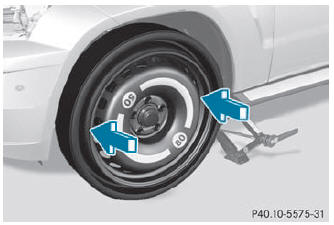
- Place the emergency spare wheel on the wheel hub and push it on.
- Tighten the wheel bolts until they are finger-tight.
- Inflate the collapsible spare wheel ().
Inflating the collapsible spare wheel
![]() WARNING
WARNING
Inflate the collapsible spare wheel only after the wheel is properly attached. Inflate the collapsible spare wheel using the tire inflation compressor before lowering the vehicle.
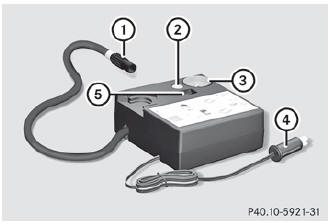
- Pull connector 4 and the air hose out of the housing.
- Remove the cap from the valve on the collapsible spare wheel.
- Screw union nut 1 on the air hose onto the valve.
- Make sure on/off switch 5 of the tire inflation compressor is set to 0.
- Insert plug 4 into the socket of the cigarette lighter () or into a 12 V power socket () in your vehicle.
- Make sure that the SmartKey is in position 1 () in the ignition lock.
- Press on/off switch 5 on the tire inflation compressor to I. The tire inflation compressor is switched on. The tire is inflated. Gauge 3 shows the tire pressure.
![]() Do not operate the tire inflation compressor for longer than eight minutes
at a time without a break. It may otherwise overheat.
Do not operate the tire inflation compressor for longer than eight minutes
at a time without a break. It may otherwise overheat.
The tire inflation compressor can be operated again once it has cooled down.
- Inflate the tire to the specified tire pressure. The specified tire pressure is printed on the yellow label of the emergency spare wheel.
- When the specified tire pressure has been reached, press on/off switch 5 on the electric air pump to 0. The tire inflation compressor is switched off.
- Turn the SmartKey to position 0 in the ignition lock.
- If the tire pressure is higher than the specified pressure, press pressure release button 2 until the correct tire pressure has been reached.
- Unscrew union nut 1 on the air hose from the valve.
- Screw the valve cap onto the collapsible spare wheel valve again.
- Stow plug 4 and the air hose in the lower section of the compressor housing.
- Stow the tire inflation compressor in the designated place in the vehicle.
Lowering the vehicle
![]() WARNING
WARNING
Pump up the collapsible spare wheel before lowering the vehicle. You could otherwise damage the wheel rim.
- Place the ratchet wrench onto the hexagon nut of the jack so that the letters AB are visible.
- Turn the ratchet wrench until the vehicle is once again standing firmly on the ground.
- Place the jack to one side.
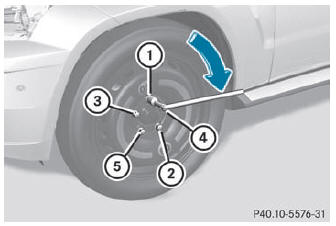
- Tighten the wheel bolts evenly in a crosswise pattern in the sequence indicated (: to A). The tightening torque must be 110 lb-ft (150 Nm).
![]() WARNING
WARNING
Have the tightening torque checked immediately after a wheel is changed. The wheels could come loose if they are not tightened to a torque of 110 lb/ft (150 Nm).
- Turn the jack back to its initial position and store it together with the rest of the tirechange tool kit in the cargo compartment.
- Transport the defective wheel in the cargo compartment.
For further information on stowing the collapsible spare wheel, see ().
![]() When you are driving with the collapsible spare wheel mounted, the tire pressure
loss warning system or the tire pressure monitoring system cannot
function reliably. Only restart the tire pressure loss warning system/tire pressure
monitoring system when the defective wheel has been replaced with a new wheel.
When you are driving with the collapsible spare wheel mounted, the tire pressure
loss warning system or the tire pressure monitoring system cannot
function reliably. Only restart the tire pressure loss warning system/tire pressure
monitoring system when the defective wheel has been replaced with a new wheel.
Vehicles with tire pressure monitoring system: all mounted wheels must be equipped with functioning sensors and the defective wheel should no longer be in the vehicle.
See also:
Remote Keyless Entry (RKE)
This system allows you to lock or unlock the doors and
liftgate, open the liftgate flip-up window, or activate the
PANIC alarm from distances up to approximately 66 ft
(20 m) using a hand-held Remote Keyless Entry (RKE)
transmitter. The RKE t ...
Useful information
This Operator's Manual describes all models and all standard and optional equipment
of your vehicle available at the time of publication of the Operator's Manual. Country-specific
differences are possible. Please note that your vehicle ...

 Where will I find...?
Where will I find...?